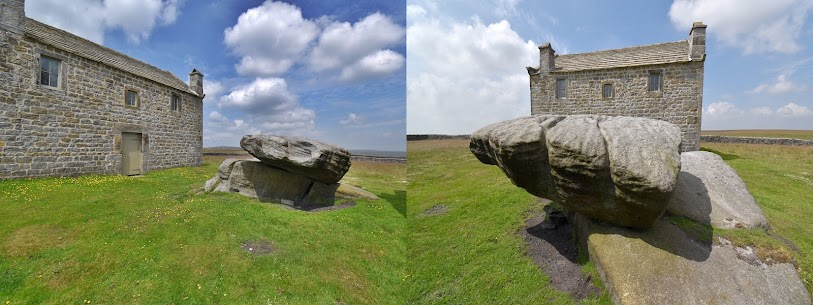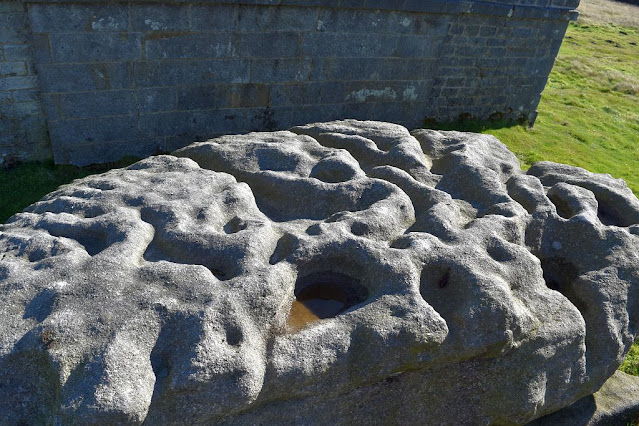Rocking Moor is an area of high moorland, three miles to the east of Bolton Abbey, and ten miles to the west of Harrogate
The moor is named after a large rocking stone, which sits on top of an earth-fast boulder near the highest part of the moor. In most cases, rocking stones are natural features created by erosion, or when a boulder has been left fortuitously stranded during glacial times. The upper stones can weigh several tons, but if they only rest upon one or two pivot points, they can be finely balanced, and will move or 'rock' when pushed.
Originally this rocking stone sat in isolation on the high moor, with panoramic views over the surrounding landscape. However, sometime during the 17th century a stone building was erected alongside the rocking stone, perhaps being used for hunting or other recreational purposes by the owners of the Bolton Abbey estate. The positioning of the building 'face on' to the rocking stone would seem to indicate that the stone was the focal point of the site, and that it had some local significance.

|
| Rocking Hall |
The recreational nature of the site was perhaps confirmed in the
mid 1700's, when the Duke of Devonshire built a quirky Georgian style shooting
house directly in front of the rocking stone. This building was known as
Roggan Hall or Rocking Stone Hall, where the duke's shooting parties could
shelter and take refreshment in relative comfort. The positioning of the new
shooting house relegated the rocking stone to the rear of the building,
suggesting that the stone was no longer regarded as the main focus of the
site, but that it was still preserved as a curiosity.
Anyone walking across the moors to visit the rocking stone today is presented with quite an odd scene - two isolated buildings in the middle of nowhere, with the rocking stone sandwiched between them. These sit within a large grassed enclosure surrounded by a perimeter wall, which all looks oddly out of place on the heather moorland.
Today, the rocking stone overhangs the edge of its base, but unfortunately it no longer rocks. William Grainge (1871) noted that the stone had still rocked "within living memory", so this would be sometime during the early 1800's. The rocking stone appears to have been 'disabled' deliberately, as the stone surface below the lower pivot point has been chiselled away, and this has dropped the upper stone just enough so that it now rests firmly on the lower rock. Whether this was an act of vandalism is unclear, or it may have been the land owners attempt to stop people visiting the stone to rock it. During the 1800's there seems to have been a craze for people to try and break or topple these ancient rocking stones. At some sites, gangs of men rocked the upper stone so violently that it was thrown off its balance point, while at other sites, levers and ropes were used to actually topple the rock from its base.

|
|
Upper surface of the rocking stone |
On closer inspection of the rocking stone it was perhaps no surprise to
finds that its upper surface is covered in a series of eroded basins, cupmarks, and snaking grooves. When early antiquarians found these kind of markings on
isolated crags and stones, they took them to be signs of Druidic worship,
however there is no evidence for this, and in most cases the basins are
natural. Elsewhere, such rock basins do have folklore attached to them, often
connected with healing properties and good luck. Unfortunately, no folklore
has been recorded for this particular rocking stone, but in other parts of
Britain it was believed that they had the power to heal diseases such as
rickets. Children suffering from this illness were laid upon the stone and
rocked, perhaps with a charm or prayer recited over them.

|
|
The Giant's Rocking stone (Bottrell 1873) |
The unusual arrangement of these rocking stones was often attributed to a supernatural event, such as a giant throwing or placing them into position, with any markings on the boulders pointed out as the giant's finger marks. This supernatural origin seems to have given the rocking stones certain powers - either to heal, or provide good luck, or even to become a witch (healer?).
In some areas, rocking stones were called Buck Stones, from Old English Bug-Stan, with Bugge meaning a type of hobgoblin. This again links the rocking stones with a type of supernatural being who was perhaps originally thought to dwell within the rock, and to be the source of the healing power. This may have been a relic of the Norse belief in the Dvergar or dwarfs, who were believed to dwell within rocks, and to have magical powers. In legend the dvergar are skilled in many crafts including the healing arts, and can be approached with a request for help . (See the Runswick Hob Holes post).
The association of rocking stones with both giants and smaller dwarf
or hob like beings occurs at other folklore sites (see the Baysdale Giant's
Lapstone post), and hints at some now obscure link between the two. This
link can also be seen in the 'Hobthrush' name, containing hob (a goblin) and
thrush a word traced back to the Norse 'Thurs', meaning a giant. In folklore
the Hob is small, but incredibly strong, so the Hobthrush name may have
signified something like the 'little giant'.
The building of the earlier lodge house on the top of the high moor,
with its door facing directly out to the Rocking Stone, does suggest that
the stone was of some significance. If, like other rocking stones, it was
believed that this one could heal illness and disease, then it would have
been visited by people from the surrounding area, and perhaps even further
afield. In such a situation, the remote and exposed location of the site
would need a shelter of some kind for the sick, so is it possible that
the Clifford family, who acquired the old abbey estate lands, provided the house
for this purpose? 100 years later, the estate had changed
hands, and perhaps the new owners did not approve of any superstitious
practices connected with the rocking stone, so they had it lowered until it no longer rocked?
After Thoughts
During the 17th century (when the lodge house was built),
crowds of people - both rich and poor, were still visiting Saint Mungo's
holy well at Copgrove (near Harrogate) for the healing of diseases and the
lifting of witch curses, etc. Around this time the landowner had a house
built alongside the well, where visitors could rest after their immersion and
prayers in the cold waters, or to sleep overnight and continue the healing
rituals over several days.
An outcrop called the Raven Stones is located on the same moor as the rocking stone (700m east of it). The outcrop is a prehistoric rock art site with 4 groups of cup markings, one rock having over 30 cup marks. There are no other rock arts sites in this area, and this is the nearest outcrop visible from the rocking stone. Compare this with the cup marked stone at Brimham Rocks, which also seems to be placed a 'respectful' distance from the unusual rock features - possibly sacred sites in prehistoric times?

|
|
Cup marked rock at Raven Stones Crag - Rocking Moor |





Post a Comment